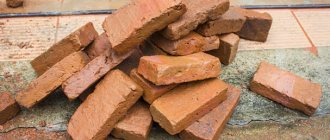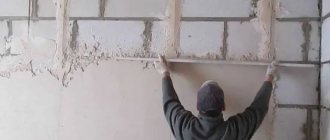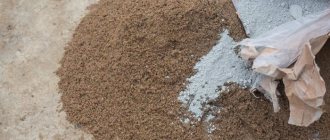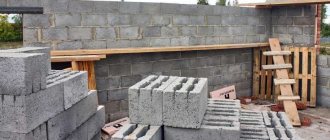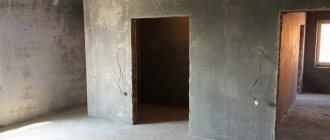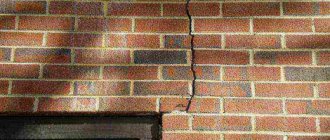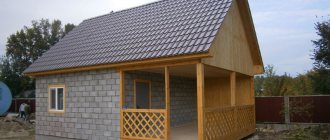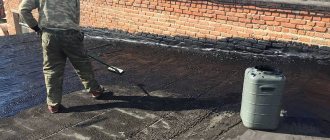After time, any brick buildings require restoration; the reasons for the violation of the integrity of sections of brick walls can be the shrinkage of the foundation, weathering of the cement mortar along the masonry joints, exposure to precipitation, temperature changes, and the like. How to restore a brick and prevent further destruction of the brickwork?
Repairing brickwork is a whole range of activities, including assessing the condition of brick walls, removing deteriorated elements, cleaning the surface, preparing building mixtures and restoring bricks. Proper care and timely repair work are necessary measures that can extend the life of buildings and structures.
Causes and consequences of masonry destruction
Violation of the external and internal integrity of brickwork occurs for many reasons.
The most common of them are incorrect calculation of the maximum permissible load on the foundation and violation of construction technology. In addition, the masonry begins to collapse if the soil is heterogeneous, there are no expansion joints and the upper aquifers are close to each other. And also among the reasons are the shrinkage of the foundation, violation of the depth of its foundation and deformation processes in beams that arise due to exposure to moisture. Excessive weight load of snow cover also affects. A thick layer of snow puts significant pressure on supporting structures, resulting in their weakening and destruction. Often the cause of the beginning of damage to the integrity of the masonry is a leaking roof. Water penetrates inside brick walls and has a destructive effect on the material.
The destruction of the masonry occurs gradually, and the stress that arises at its first stage is absolutely invisible to an outsider. Only a professional can sense that something is wrong, who can recognize the beginning of destructive processes by the appearance of microcracks. Over time, microcracks grow, connect with each other, form a network and attack vertical seams, which, in turn, threatens to seriously damage the integrity of the building. The most negative consequence of such processes is the unhindered passage of cold air inside the walls, resulting in their freezing.
With the onset of heat, the brick begins to thaw, as a result of which the wall becomes damp and becomes a favorable environment for the appearance of mold. In addition, the decorative coating also begins to crack and peel, and the plaster and ceramic tiles begin to fall off. At the initial stages of destruction of the masonry, when visible deformation processes are not yet observed, rusty spots may begin to appear on the walls. This indicates ongoing corrosion processes on the reinforcement or embedded parts located inside the wall. To combat the destruction of brick walls, as well as to increase their strength and durability, they use the injection method - sequential pumping of various materials into the masonry.
Injection of brickwork
Our company provides qualified injection services for brick and rubble masonry. This also applies, first and foremost, to ancient and historical buildings, which are subject to special requirements when carrying out restoration work.
As a rule, the ultimate goal of masonry injection work is to increase the load-bearing capacity, fill voids, restore and, if necessary, renovate. Very often it is necessary to carry out “cut-off waterproofing”.
When using injection technology, it is possible to avoid larger measures, such as complete disassembly of defective areas
This is especially important during restoration work, when the least damage needs to be done to the object.
Advice
Injection work on brickwork involves drilling holes and pumping repair compounds on a mineral or polymer basis through packers/injectors installed in them, depending on the tasks assigned and the technology of work.
It should be borne in mind that the location of the drill holes depends not only on the design, but also on the material for injection.
So, when pumping mineral compositions, the distance between packers to effectively fill voids should be no more than 12-15 cm! Very often in projects there is a distance of 300 - 500 mm, but it should be borne in mind that the filling of voids in this case will be localized mainly around the hole and you should not expect complete filling of the voids in the masonry. However, when using polymer compounds, a distance between holes of 300 mm is quite justified, due to their increased fluidity.
At Inject LLC you can always receive qualified assistance from our specialists in the above-mentioned works.
INJEKTSCHLAUCHSYSTEM (INJECTSHLAUCHSYSTEM). The basis of the INJECT SYSTEM...The coupling for packers with a collet head (nozzle) is...The collet head for the packer is an adapter that allows convenient, quick and...The coupling for packers with a flat head (slide connection) is...
*The Inject line of injection materials has passed the “Expert Commission on Innovative Technologies and Technical Solutions” and is included in Register No. 4/2013, and Register No. 1/2016 dated 02/29/2016 of innovative technologies and technical solutions used in construction projects city order of the city of Moscow.
Replacing masonry
Restoration of external walls is possible using one of the following technologies:
- counter drilling. Holes are drilled at a certain distance, placing them sequentially or in a checkerboard pattern. If the wall is thick, it is best to drill from both sides, along one axis. After this, the holes are filled with creamy hydrophobic compounds;
- dismantling of individual sections of the wall with subsequent restoration. This method involves financial costs. Its meaning is that the deformed area is dismantled, after which the restoration of the masonry begins with new brick intended for restoration;
- saw technology. The brick surface is sawn horizontally, the cut zones are caulked with materials that have waterproofing properties, the gaps are filled with a mineral-based suspension, which is intended to stabilize the statics of the brickwork. The repair method is considered effective, but is quite expensive;
- strengthening walls. A good option for preserving the integrity of a load-bearing wall and restoring its load-bearing capabilities. It is carried out using metal, composite, reinforced mortar or reinforced concrete frames.
Steel clip
This is a frame system made of large cross-section reinforcing bars, iron corners, steel strips, on top of which a metal mesh is fixed. After this, the surface of the wall is plastered with cement-based or polymer-based mortars, and the second method is more effective, since the polymer-cement based mortar mixture does not create additional load on the structure and increases its load-bearing capacity by sixty percent.
Use of composite materials
Such repair of seams and other damaged areas of the facade brickwork ensures the strength of the walls against vertical compression, shear and shear along the cross section. Carbon or glass fiber is used as a reinforcing material.
Reinforced concrete cage
Its components are metal reinforcement and concrete mortar. The main characteristic is considered to be excellent strengthening ability, but there is a significant drawback - the large mass of the structure, which creates an additional load on the foundation base.
The frames may be based on pilasters, meshes or reinforcement cages. The material is fixed to the brick wall with anchors or studs, and a mortar mixture is applied on top.
According to installation methods and purpose, rigid belts are divided into several types:
- local;
- general;
- a clip mounted around the entire perimeter;
- a belt used when tearing off a corner;
- a clip installed at the point where the wall breaks;
- a belt used when the inner wall moves away from the façade.
In case of destruction of brickwork, it is recommended to use a special brick stone for restoration work. It is made by firing; the material differs in the form of non-standard sizes.
Making a new opening
There are situations when do-it-yourself restoration of brickwork involves creating a new opening at the site of destruction. Sometimes this is easier to do than to completely repair the wall. The algorithm of actions is as follows:
- the ceiling must be reinforced with beams, supporting elements and wedges;
- the outer side of the wall is reinforced with strips resting on the stands;
- the support points for the beams are moistened and filled with mortar;
- the deformed area is dismantled and a brick opening is built in its place.
Crack inspection
Depending on the stress state of the masonry, four stages of its work are distinguished. The first stage is a state of stress that does not create damage in the masonry; the second stage - the appearance of minor hairline cracks in individual bricks; third stage - with increasing load, the cracks, uniting with each other and with vertical seams, delaminate the masonry into separate seams; fourth stage - destruction of masonry
In this regard, it is very important to establish the causes of cracks in the masonry already in the first two stages. Cracks are identified by visual inspection of surfaces, as well as selective removal of protective or finishing coatings from structures. It is necessary to determine the position, shape, direction of spread along the length, width of the opening, depth, age, and also establish whether their development continues or has stopped
It is necessary to determine the position, shape, direction of spread along the length, width of the opening, depth, age, and also determine whether their development continues or has stopped.
A visual inspection consists of inspecting cracks. Highly located cracks are examined through binoculars. A clean fracture surface indicates a recent origin of the crack, a contaminated surface indicates a long-term origin.
Particular attention should be paid to identifying cracks that coincide with the seams of the brickwork, as they are quite difficult to detect
To determine the opening and depth of cracks, there are currently a number of instruments, of which the most convenient in the field is a set of probes, preferably needle-type (or templates with strokes of appropriate thickness), as well as more complex instruments - crack gauges and crack gauges (Fig. 2 ).
Rice. 2. Mechanical gap gauge three-axis (a) and string (b)
Important indicators are the time of appearance of cracks and external circumstances that could be the reasons for the deformation of the building. The picture of wall damage becomes significantly more complicated when cracks occur from different causes and at different times, so to analyze them it is necessary to have materials on engineering geological conditions, the history of design, construction and operation of the building, and the location of underground networks.
The results of crack inspections must be presented clearly. Cracks are applied to diagrams of facades, interior walls, and wall layouts.
For clarity, the diagram can be made in axonometry. The cracks are numbered, their length and dimensions (opening width, depth) are indicated, their beginning at a given point in time is noted, and the locations and numbers of the attached photographs are indicated. During long-term observations, deformation marks (beacons) are installed in the place of greatest crack development.
The lighthouse is a plate 200...250 mm long, 40...50 mm wide and 6...10 mm high, placed across the crack (Fig. 3). The preferred lighthouse material is gypsum or cement-sand mortar.
Rice. 3. Gypsum lighthouse
Two glass or metal plates, each fixed at one end on different sides of the crack, or a lever system, are also used as a beacon. The rupture of the beacon or the displacement of the plates relative to each other indicates the development of deformations. In dry rooms it is allowed to install beacons made of paper strips.
The lighthouse is installed on the main material of the wall, having first removed the plaster from its surface.
It is recommended to place beacons also in a pre-cut groove. In this case, the hole is filled with gypsum or cement-sand mortar.
The location of the cracks is schematically plotted on the wall layout diagram, noting the numbers and date of installation of the beacons.
Beacons are inspected a week after their installation, and then at least once a month. In case of intense cracking, daily monitoring is required. When observing the development of a crack along its length, the ends of the crack are fixed with transverse strokes during each inspection. The date of inspection is indicated next to each stroke. The observation log records the number and date of installation of the beacon, the location and layout, the initial width of the crack, and changes in the length and depth of the crack over time. If the beacon is deformed, a new one is installed next to it, which is assigned the same number, but with an index. Lighthouses on which cracks have appeared are not removed until the end of observations.
If no change in the size of the cracks is detected within 30 days, their development can be considered complete, the beacons can be removed and the cracks can be repaired.
Lab tests
Laboratory tests are one of the necessary stages of professional restoration.
Substances are taken from various points in the masonry and analyzed for the content of nitrates, sulfates, salts and moisture. When visually examining capillaries, moisture cannot always be detected. For laboratory analysis, a sample is taken from the masonry at three (minimum) points, the percentage is measured and the results are compared. If too much capillary moisture is found, cut off.
The content of salts (sulfates and nitrates) is assessed similarly. If it is discovered that there are a lot of them, a set of measures is taken to prevent the harmful effects of these compounds on the brick. In addition to surface cleaning, cupping is also carried out - the salts are converted into an insoluble state. This method consists of a special chemical treatment, as a result of which the hygroscopic swelling of salts stops, which prevents them from reaching the surface of the brick, thus stopping the destructive effects of harmful chemical compounds.
Filling seams and cracks with mortar is carried out using a trowel and grater.
In case of significant “salinization”, very light porous compounds are used, which are applied to the masonry. They “pull” the salts onto themselves, after which the plaster is knocked off and thrown away. Then laboratory tests are made again and, depending on the result, either everything is repeated, or the work moves to the next stage. If, according to the project, the wall is to be plastered, then a mixture of sanitizing plaster and salt-accumulating plaster is used as the final layer.
When does the need arise?
Reinforcement of a brick stone wall by injection is performed in the following cases:
- to stop destructive processes;
- the need arises to create a hydrophobic barrier on the line of moisture penetration through the pores of the building material and cracks in the walls;
- to fill the emerging lumen areas with a dense mass;
- in order to obtain the effect of reinforcement with hardened polymer components;
- strengthen the insulating qualities of the base in grounded structures;
- form a bunch of diverging parts into one whole.
The injection method of forming additional waterproofing in the wall is used in the construction and repair of buildings and structures of various levels of complexity - subway lines, underground parking lots, sewer system collectors, swimming pools, basements, etc.
The composition of the injected injection depends on the level of destruction of the building material and structural differences of the object.
Repair and strengthening of brick walls
Repairing brickwork of external walls using jointing
If the reason for the deformation of the masonry is weathering of the seams to a great depth, then this worsens its thermal characteristics and also reduces the load-bearing capacity. Such a defect can be eliminated by strengthening the seams with cement mortar.
Before joining the walls, the seams are cleaned and thoroughly washed with water. Then they should be filled with cement composition and smoothed with a special tool.
Lintels with single cracks are restored by injecting a liquid composition (polymer cement or cement) into them.
When eliminating defects in arched lintels, the load is initially removed from them and then completely shifted.
Repair of ordinary and wedge lintels is created by strengthening the liner of reinforced concrete or steel beams.
Repairing cracks in brick walls
After the building has completed shrinkage, small flaws in the brickwork can be eliminated with concrete mortar, having prepared the wall in advance. If they are wide enough and in large quantities, then re-lining the damaged area is used.
Restoration of severely deformed areas of brickwork
The loss of the load-bearing capacity of some parts of the wall leads to the need to replace them with the entire thickness of the outer brick wall. This method allows you to completely restore the building to its original appearance and eliminate the defect as accurately as possible.
Progress:
- Initially, you should create a temporary fastening of the upper section of the wall that is not subject to replacement;
- then you need to disassemble the damaged area and re-arrange it. For this purpose, brick and mortar M100 is used;
- The masonry must be carried out with the bricks fully seated. The top between the old and new masonry is carefully sealed with a semi-rigid cement mortar M100;
- when laying the walls, which will then be included in the joint work, it is allowed to use wedging of the mixture using steel wedges;
- dismantling of the temporary fastening is done after reaching 50% of the design strength of the new masonry.
Recommendations:
- before starting work on relaying walls, it is necessary to eliminate the causes of deformation;
- load-bearing brick walls that do not need to change floors are re-laid with preliminary installation of multi-tiered temporary fastenings;
- temporarily created fastenings are removed a week after the completion of the last tier of masonry;
- Before unloading the required area from the wall above, unloading beams should be laid above it on both sides, punching and sealing their furrows. The planting of the latter begins from a weaker area. All this can be done using a pneumatic hammer. The vertical gaps between the masonry and the beam are filled with a plastic cement composition, and the gaps between the lower surface of the masonry and the top of the beam are treated with a hard and greasy cement solution.
Stiffness belt
To reduce the sensitivity of brickwork, builders introduce a special rigid belt (channel) into it, which subsequently absorbs tensile forces and stops the development of deformation.
Types of rigid belts:
- local;
- arranged around the perimeter of the building;
- are common;
- used when tearing off a corner of a structure;
- used when separating the outer wall from the inner wall;
- used when breaking a building.
The steps to create a stiffening belt are carried out one by one:
- first on one side;
- then from the opposite one.
The main condition for arranging stiffening belts is the installation of coupling bolts.
Repairing a crack on the facade of a building video:
List of sources
- kirpichspec.ru
- stroykirpich.com
- ostroymaterialah.ru
- gid-str.ru
- www.Alpis-M.ru
- olymp.in
- mymylife.ru
- rosbuildgroup.ru
- sampochinil.ru
Visual inspection
First of all, an assessment of the technical condition of the object is carried out.
During the inspection of brick facades, the following problems are revealed:
- delamination of masonry;
- open faults;
- deviations from vertical position;
- destruction of individual stones in the brickwork of external walls;
- bulging of some areas with their subsequent destruction.
As soon as initial faults and deformations are discovered, the causes contributing to this should be identified and eliminated, and the situation should be continuously monitored. If this is neglected, cracks may form again after restoration measures.
Deformation processes should be monitored from the moment the cracks open by more than ten millimeters. The action consists of measuring the depth of the faults and installing beacons made of gypsum mixture or paper strips along problem areas.
When the wall is covered with plaster, the stones are exposed at the points where the beacons are placed.
Restoration of the brickwork of the facade begins if the exposed beacons signal that the phenomenon of deformation has disappeared.
Sealing cracks
Cracks, the degree of expansion of which does not exceed five millimeters, are sealed with a cement mortar mixture. Before repairs begin, the problem area is cleared of small debris and moistened. The surface is cleaned with a brush, a grinder or an installation that pumps air under high pressure.
In order for the restoration of the brick facade to be successful, and for the stone to firmly adhere to the masonry mortar, it is recommended to knock down its edges a little using a hammer.
Cracks whose width is five to ten millimeters are repaired in a similar way, only in this case a regular masonry mixture is used.
Places where the width of the cracks exceeded one centimeter deserve special attention. In this case, the repair of the brick facade of the building is carried out using various methods:
- Vertically located cracks are sealed with foam for installation work. It is blown into the cracks, cut out a couple of centimeters inward, and the gap areas are covered with a mortar mixture;
- horizontal cracks along the entire length at certain points are anchored using dowels and sealed with mortar;
- Partial dismantling of the old brick wall and repairs are being carried out. Part of the masonry from the top to the bottom zone is dismantled, the free area is sealed with restoration bricks placed in a “lock”.
Renewal of sutures
Weathering of delaminated mortar from the seams initially seems like an insignificant defect, but you need to know that water entering the room through damaged joints becomes the main reason for the onset of wall destruction.
The reasons for weathering of seams are different, and you should not waste time identifying them - it is better to take measures to eliminate the problem. The algorithm of actions is as follows:
- the seam areas should be cleaned of mortar residues using a special hammer or chisel, and sweep away the dust with a hard-bristled brush;
- the area prepared for repair is abundantly moistened;
- the seam is filled with an adhesive mixture and stitched.
Waterproofing
The main danger to the wall is water, and it is necessary to carefully protect the masonry from such a negative impact. After carrying out repair and restoration activities, it is necessary to devote part of the time to waterproofing measures, for which purpose special cement-based compounds are used.
The main condition for applying such compounds is a dry and clean surface.
If the wall previously had a covering layer of paint, which was damaged during repairs and also requires updating, the restored area is covered with a primer.
Guide to Strengthening Brick Walls
- Stages of deformation of brickwork
- Method of strengthening brick surfaces
- Restoration of brick partitions
- Carrying out repairs and restoration of brickwork Recreating the brick covering by jointing
- Getting rid of cracks in brick floors
- Restoration of areas with severe wear and tear
Any building, regardless of whether it is residential or abandoned, is subject to gradual destruction. The walls, foundation, and brick itself are deformed. The basis for such manifestations may be errors of builders during the construction of the structure, improper operation of the building, and low performance of design work. Timely elimination of such consequences will return the building to its former appearance and extend its useful life. Strengthening brick walls can help in such a situation.
Deformation of a brick wall requires reinforcement. By strengthening the masonry, the load-bearing capacity of the wall can be completely restored.
Why is the integrity of the brickwork compromised? This may be affected by:
- Heterogeneity of the soil composition under the building.
- Increased load on the foundation and load-bearing elements.
- Lack of expansion joints between parts of the structure.
- Uneven load on the soil foundation.
- Foundation subsidence.
Recovery process
Let's figure out how to properly repair brick walls.
Necessary tools for successful completion of work:
- pneumatic hammer;
- Sander;
- boaster;
- jointing;
- jumper;
- trowel;
- scrap;
- pick;
- sledgehammer;
- wedges;
- electric drill;
- hammer, brush.
In addition, materials will be required to restore the seams in accordance with the chosen repair method.
How to repair brickwork yourself?
Firstly, you need a special set of tools and solutions, namely:
- hammer drill
- drill;
- hammer;
- chisel;
- jointing;
- Master OK;
- metal brush;
- construction dye, additive;
- cement mortar.
Step-by-step restoration of brick walls
To monitor the expansion of cracks in brick walls, gypsum (a) and plate (b) beacons are used.
Only when you have firmly strengthened and fixed the wall can you proceed directly to the repair, that is, restoration. Using a drill with a special attachment, cut the bricks that need to be removed and all their adjacent seams. Using a hammer and chisel, knock down the joints around the perimeter of the damaged brick, break up its fragments and remove them. At the same time, try not to damage entire bricks nearby. Restoration of brickwork at this stage requires maintaining their integrity
These bricks should be carefully cleaned of old mortar by first moistening them with water from a hose or using a damp sponge.
Prepare the mortar by adding an admixture for better adhesion. You can also add dye here if necessary. Apply the mortar on all sides of the gaps from the removed bricks. The layer of mortar should be at least 2 cm. Next, soak the bricks in water, coat all contact sides with mortar and insert them in place of the removed ones. To install the bricks correctly, you need to tap each one with the handle of a trowel, then they will lie more evenly, without distortions. While working, fill the joints, joint the seams, and do not forget to wipe away any spills. Upon completion of repair work, remove supports and other reinforcements.
As practice shows, restoration in the construction industry (especially detailed restoration) is one of the most relevant today.
Potholes, chips, loss of bricks and joint material
Strengthening weak areas of the wall by replacing masonry is used when there is significant damage.
In some cases, it may be necessary to keep very old, ancient materials intact. Most often, this situation arises when working with historical masonry and is called preserving historical substance. Here, during a visual inspection, it is important to identify all weak spots. The strength of the material is determined in the laboratory. If necessary (if the strength is insufficient), the masonry is strengthened with compounds containing silicon. Brick is restored with restoration mortars, and sutures are used for seams. They must match the sample in terms of strength, grain size and color, this is determined in laboratories. Without laboratory tests, the restoration will be of lower quality.
Types of brickwork restoration
There are several ways to restore a brick wall. The technology is selected depending on the causes and degree of deformation. However, before proceeding to the main stages of work, it is necessary to prepare the structure. Restoration is carried out as follows:
- Thoroughly clean the masonry from dust and dirt.
- Use strong water pressure to wash off any remaining plaster.
- Dry the wall by spraying it with heat from a gun or a hair dryer.
- If there are cracks, it is necessary to remove detachments or mortar that does not adhere well.
Injection of the structure
Caulking is used to restore sand-lime brick with your own hands if large cracks and formed cavities are observed. To eliminate them, according to this method, use:
- epoxides;
- polyurethane;
- minerals.
This method is one of the most effective of all used. Injection is carried out according to the following algorithm:
- Treating the wall with a special solution that does not allow moisture to pass through.
- Packing the crack.
- Installation of parkers into the cavity.
- Administration of injection solutions under pressure. In order for the mixture to penetrate into the smallest cracks, you can add fine sand to it.
Repairing the masonry
When performing this technique, it is assumed that the wall will be completed with missing elements. This method helps to refresh the appearance of a brick structure. This restoration technology is quite labor-intensive, since it requires exclusively manual work and processing of a limited area. The repair of brickwork is carried out in stages:
- Grinding and cleaning of old material.
- Washing with water the place where the old masonry comes into contact with new fragments.
- Installation of new material on the mortar, observing the dimensions of the seams, the order of laying out and dressing with old fragments.
- Cleaning the newly installed material from solution drips.
Strengthening structures
The design can be updated by improving the strength characteristics. The technique is used if it is necessary to restore a fragment that is located in an area where the foundation has sunk. To strengthen it, it is necessary to install piles under the base of the wall. This process is labor-intensive and requires strict adherence to the rules and step-by-step execution of work:
- Expose part of the foundation where it has sunk.
- Go deeper under the foundation and install formwork and reinforced frame.
- Line the bottom with 5-10 cm of gravel.
- Pour concrete and let dry.
- Repeat the procedure after 1-1.5 m.
Masonry jointing
If a low-quality solution is used during long-term use, it may be necessary to restore the seams. The procedure consists of jointing the interbrick space in order to further fill it with a new mixture. Work algorithm:
- Unstitch the seams as deeply as possible using a chisel.
- Remove dust and dirt.
- Introduce a solution with an adhesive mass into the cavity.
- If damaged fragments are identified, they must be replaced.
Other restoration methods
You can restore a brick wall by removing moisture from the pores in the material and minimizing salt deposits. This can be done using special solutions. They are applied to the surface of the brick structure and, penetrating its structure, remove sulfates to the outside. After the material has dried, it must be cleaned off with a spatula.
https://youtube.com/watch?v=D76DRUuuOrs
Recommendations
So, we figured out how to repair a bulging brick wall or other defect. Let us once again repeat the recommendations of experts who will help you in your independent work:
- determine the cause of the defect;
- monitor the dynamics of the development of cracks and other deformations;
- prepare everything you need for work;
- restore the integrity of the walls or carry out restoration work.
During the work process, proceed as follows:
- Before starting restoration measures, eliminate the causes that caused the identified deformations;
- When rearranging façade walls, be sure to use multi-tiered additional fasteners;
- removal of fasteners is permitted if at least one week has passed since the completion of the repair;
- an additional thermal insulation layer will not only create protection from cold weather and moisture, but will also hide the consequences of repairs;
- When filling cracks, use a trowel and a shield with a handle. Apply the mortar mixture from bottom to top vertically into cracks, and from left to right into horizontal cracks.
Correctly assess the scale of the problem and your own strengths, determine the nature of the damage. If you have the slightest doubt, seek help from experienced professionals.
Remember that only high-quality restoration guarantees the continued operation of the building without recurrence of problems.
Reasons for the destruction of brick walls
The structural integrity of brick walls is violated for several reasons, the main one of which is the general settlement of the building. A year or two after completion of construction, the building will still shrink and restoration of the wall will be required in any case. The pressure of the masonry on the foundation causes inevitable deformation of the latter, which leads to a defect in the base. And then the crack runs along the entire height of the brick walls. You can also add the influence of precipitation here. In addition to cracks, wall deflection may occur. This happens due to the strong pressure of arches and ceilings. In this case, you should find out the cause of the deformation, and only then decide whether to restore the wall or demolish it, building a new object taking into account all the errors. Let's talk in more detail about the restoration of old brick walls. First of all, it is necessary to assess the quality of the masonry, carry out a visual inspection of the seams, and determine the condition of the bricks and masonry composition. In other words, cutting is carried out.
Types of damage
In order to perform high-quality finishing of the brickwork, it is necessary to correctly determine the type of damage. These include:
- chipped areas, cracks, other mechanical defects;
- the appearance of deformations causing cracking and peeling of the plaster coating from the brickwork;
- the appearance of rusty spots, confirming the development of corrosion on metal embedded elements. Such phenomena have a negative impact on the structure and destroy it;
- protrusion of stones due to errors made during the laying process, the negative influence of weather factors.
Installation of reinforced concrete belts
Reinforcement of the surface with a reinforced concrete cage is carried out by fixing it around the entire perimeter - in this way a reinforcing mesh is formed.
This method of restoring brick walls is characterized by significant cost savings. It is carried out in a short time, but during its construction the pressure of the mass on the base increases noticeably
When using a reinforced concrete structure, it is important to take into account technical indications such as:
The reinforced concrete frame is attached with clamps to the brick wall along the entire perimeter, forming a reinforcing mesh.
- The clip is 4-12 cm thick.
- Fine-grained concrete mortar of at least class 10.
- Longitudinal fittings type A240-A400/AI, AII, AIII class.
- Transverse reinforcement A240/AI class, distance no more than 15 cm.
Reinforcing the surface with a reinforced concrete layer is associated with fastening the reinforcing mesh along the entire base; it should be secured with special latches. To restore the integrity of the wall, a kind of shell with a very strong coating is created. The result of its impact is determined by the condition of the masonry itself, the strength of the concrete coating, and the percentage of surface reinforcement. This design is able to take on a small share of the load, thereby facilitating the laying.
Small layers of the clip are fixed to the surface, after which the base is plastered. High layers are organized using formwork and strengthened along the entire height.
Installation of a composite clip is also used.
The steel structure compresses the masonry on both sides, thereby increasing its level of resistance.
The use of composite raw materials gives the best results for strengthening the brick surface. The raw materials are based on strong fibers and glass fiber materials are used. They increase the compressive and shear strength of structures. The prepared brick is treated with mortar and then primed. Then the metal frames are attached and temporary fastenings are removed, the walls are painted and plastered.
If walls are reinforced with steel structures, then the steel frame is a metal device that significantly increases the main purpose of the surfaces.
To build such a structure, reinforcement bars d up to 12 mm or steel clamps are used; they are welded to the corners. They are placed in the solution at corner points to strengthen the area. Such elements are located at a distance of 500 mm. The steel corners are covered with a metal mesh on top. For large volumes of work, a mortar pump is used.
The brick can be strengthened when the matter is brought to its logical conclusion, which will cause the damage to resume. It is necessary to carry out reconstruction in a timely manner, which will prevent the walls from collapsing. The considered methods for strengthening brick surfaces make it possible to increase the stability of the device to loads, deformations and factors of seismological significance.
How do you know when it's time to repair?
Repair of the front surface of external brick walls begins immediately after damage is detected and the root causes are eliminated
Before work, it is important to determine the condition of the masonry and seams, the degree of destruction of the surface. Damage to the cladding occurs in several stages:
- Under the negative influence of weather and mechanical factors, tension appears in the masonry, imperceptible to the unprofessional eye, but obvious signs of destruction have not yet been observed.
- Small cracks called “hairline” cracks appear in some places on brick blocks.
- The cracks spread over a large area, combining into one large one, and the vertical part of the seams is captured, causing the masonry to be damaged and crumble more.
- If the destruction is not eliminated at the previous stages, damage to the brickwork and facing layer begins.
Why do deformities appear?
Repairing masonry is a specific set of measures, which includes a general assessment of the structure, removal of certain elements that have reached an unusable state, cleaning, preparation of mortar and restoration measures. All this is necessary to extend the operational life of the facility.
Considering the degree of destruction of the walls, one of the existing methods is used to restore it.
The main reasons for the destruction of brickwork are:
- the difference in the density of the soil composition, due to which the structure begins to subsidence;
- significant load impacts on the foundation;
- absence of expansion joints;
- negative impact of atmospheric phenomena and groundwater.


